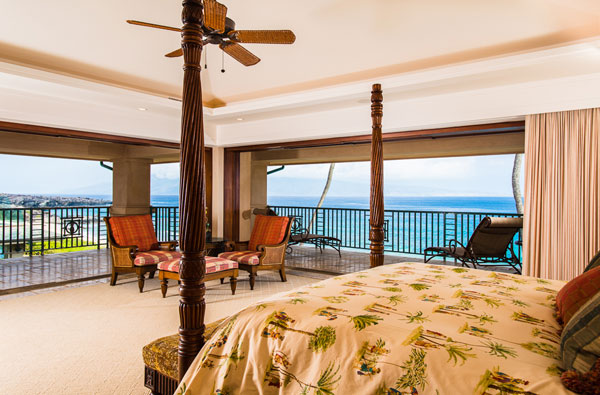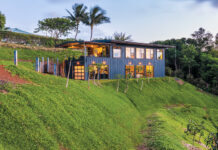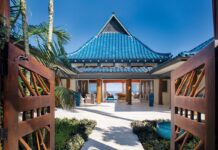Story by Heidi Pool | Photography by Travis Rowan

When William O’Neil was designing a home for the oceanfront property he purchased in Kapalua in 1996, feng shui was the farthest thing from his mind. Yet the house he and partner David O’Neil have dubbed Hale Ali‘i Kapalua (Kapalua Palace) “is a perfect example of feng shui principles,” says Kanoe Marciel Merino of Maui Feng Shui by Kanoe. “When you enter, there’s a sense of balance, warmth, and welcoming energy.”
William’s not a trained architect, but his sketches for Hale Ali‘i Kapalua were so detailed and meticulous that when he consulted with the late architect Brian Bolter, the latter said, “I’m not sure why you need me.”
Like the yin and yang of ancient Chinese schools of thought, William and David counterbalance each other’s personality. William, who is retired, is straightforward and grounded; David gravitates towards spirituality. As CEO of Energy Talk Radio, David delivers radio programming that focuses on wellness for the body, mind, and spirit. It was his idea to retain feng shui-expert Kanoe to analyze their home and confirm its positive architecture and energy.
According to Kanoe, the Chinese developed feng shui some 5,000 years ago as a system for determining where to erect buildings for maximum comfort and balance, based on the topography of the land. Contemporary practitioners believe a home can achieve sublime harmony by incorporating the five feng shui elements: fire, earth, metal, water, and wood. “Hale Ali‘i Kapalua embodies each of these elements,” she says.

Water is the first element you notice; the home’s entryway naturally draws the eye to an infinity pool, and beyond, to shimmering Oneloa Bay. Moloka‘i seems near enough to touch, and little wonder. This is the closest point between the two islands, with fewer than nine miles of ocean separating them.
When William purchased the three-quarter-acre lot, there was no ocean view. “Oneloa Beach was covered with ironwood trees,” he says. “Ironwood doesn’t grow here naturally, and it’s extremely invasive.” So he had them removed — a massive project that required eight men and three weeks’ time.
Through his landscaper, Bryan Maxwell, William learned that a property owner in Kihei was going to remove five fifty-foot-tall palm trees that had been planted in the 1940s. “I wanted them, so Bryan dug them out, loaded them onto two flatbed trucks, and brought them here.” The operation took six hours, and involved a police escort and partial shutdown of the Honoapi‘ilani Highway.
While the property’s palm, orchid and shower trees exemplify the feng shui element of wood, so does generous use of African mahogany in the home’s interior. All built-ins, cabinetry, and window casings are mahogany; the staircase combines mahogany and coconut wood.

Kanoe says the home’s generous scale adds a sense of expanding energy. Stone flooring, representing the earth element, provides a grounded strength and balance. Italian travertine the color of sand is used upstairs and down, indoors and out. William even had the flooring laid in the kitchen before the cabinetry and appliances were installed so the Versailles pattern would remain unbroken.
The roof is China sea green slate, a choice, Kanoe notes, that echoes the surrounding mountains. It almost didn’t happen. “Our homeowners’ association bylaws [require] copper roofing,” says William. “But I was determined to use slate, since it’s more durable, less costly, and actually resembles aged copper. I was able to persuade the association board to approve my slate roof, and with a 100-year life, it will last longer than I will.”
The home contains four master bedrooms, all en suite, with one on the lower level designed for William’s elderly mother. Two master suites upstairs have commanding ocean views and broad lanai for whale watching or enjoying West Maui’s legendary sunsets. Pineapple motifs, which William says symbolize hospitality, accent wrought-iron railings that represent the feng shui element of metal.

Honolulu interior designer Mary Philpotts McGrath incorporated influences from Polynesia and the Pacific Rim in creating the home’s decor. Oriental rugs bring warmth to the travertine’s coolness, while thoughtful placement of round tables, occasional pieces, and accessories soften the home’s rectilinear geometry.
Light fixtures, table lamps, and sconces deliver layers of gentle illumination, and evoke the feng shui element of fire. The home is outfitted with “Smart House” features, which integrate temperature control, indoor/outdoor lighting, sound/music, pool/spa equipment, and security.
Although they maintain a residence in Southern California, for William and David, Hale Ali‘i Kapalua is home. For now, anyway. The house is currently for sale, with an asking price of $28 million, fully furnished. The couple wants to purchase land in a yet-to-be-determined location where they’ll collaborate on “forever home” that reflects their combined tastes — “something we create together that will be our legacy,” says David.
RESOURCES
CC&D Builders Hawai‘i (contractor)
2530 Keka‘a Dr., Ka‘anapali
667-1807
Lahaina Carpet & Interiors, Inc.
1036 Limahana Pl., #31, Lahaina
661-4268 | www.lahainacarpets.com
Latitudes—Purveyors of Tommy Bahama Home
210 Alamaha St., Kahului
893-0650 | www.latitudesinhawaii.com
Martin & MacArthur
WHALERS VILLAGE
2435 Ka‘anapali Pkwy., Ka‘anapali
667-7422
THE SHOPS AT WAILEA
3750 Wailea Alanui, Wailea
891-8844 | www.martinandmacarthur.com
Pacific Audio & Communications
330 Ohukai Rd., Kihei
874-4928 | www.pachawaii.com
Worldwide Design Studio (stonework)
360 Papa Pl., Kahului
871-1440 | www.worldwidedesignstudio.com





